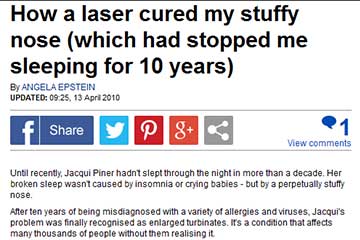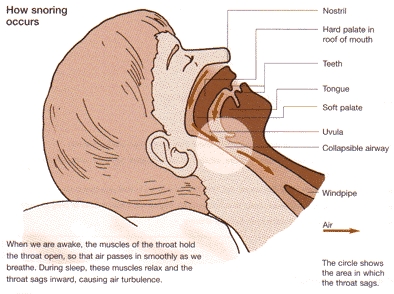
How Laser Cured my Stuffy Nose
SNORING & BLOCKED NOSE
dailymail.co.uk
How a laser cured my stuffy nose (which had stopped me sleeping for 10 years)
Until recently, Jacqui Piner hadn’t slept through the night in more than a decade. Her broken sleep wasn’t caused by insomnia or crying babies – but by a perpetually stuffy nose.
After ten years of being misdiagnosed with a variety of allergies and viruses, Jacqui’s problem was finally recognised as enlarged turbinates. It’s a condition that affects many thousands of people without them realising it.
Turbinates are the bits of bone covered by soft tissue just inside the nose where the nostril flares out. Most of the time we’re not aware of them, but when they become enlarged it can make breathing through the nose practically impossible.
![]()
Until recently, Jacqui Piner hadn’t slept through the night in more than a decade thanks to a perpetually stuffy nose.
Turbinates have a very important function,’ explains Ms Anastasia Rachmanidou, an ear, nose and throat surgeon with Lewisham Hospital NHS Trust. ‘They are there to help filter and warm air in the nose, and to trap dirt and dust particles.
‘They usually follow a cycle, so when one side is slightly swollen, the other shrinks a little so that each side has a “rest” period.
‘But in some cases they can become permanently enlarged, usually because of some unidentified allergy.’
She estimates that as many as 30 per cent of adults suffer from enlarged turbinates to some degree.
The problem is common among asthma sufferers. Ironically, long-term use of over-the-counter nasal sprays for asthma or general decongestion makes the condition worse by causing further swelling.
The ageing process can also cause the turbinates to thicken gradually, narrowing the nasal air passages and making it harder to breathe. Pregnancy can also aggravate the condition, as the tissues in the nose swell due to fluid retention.
Enlarged turbinates are more common in adults than children and can be the underlying reason for sleeping problems.
Until Jacqui’s diagnosis, having a permanently blocked nose had become a way of life for the divorced mother-of-two.
No amount of blowing her nose or use of medicated nasal sprays made any difference, and as a hayfever sufferer, her blocked nose would persist even when the pollen season was long over.
But aside from the discomfort of being unable to breathe properly, her so-called ‘stuffy nose’ had a huge impact on her life.
‘I just couldn’t sleep properly,’ says Jacqui, a sales consultant who lives in Orpington, Kent. ‘I’d fall asleep and then wake up about an hour later with a dry mouth from breathing through it. I could easily get through two litres of water a night.
‘I’d also snore terribly, which often woke me up. I’d drink some water, go back to sleep, and the whole cycle would repeat itself.
‘The blocked nose affected my whole life. I’d be tired at work all day, and had no energy for socialising in the evening. And when it came to going to bed, I just knew I wasn’t going to get any relief.
‘Over the years, doctors gave me various steroid or antibiotic sprays, though never any concrete explanation as to what was causing my blocked nose. Sprays would relieve the stuffiness for maybe half an hour, and then the trouble would start all over again.
‘Of course, what I didn’t know was that the sprays were causing my turbinates to swell even more.’
While steroid nasal drops help some sufferers, they generally stop being effective after two or three months. They can then start making the problem worse by increasing swelling in the nose.
Finally, Jacqui was referred to Mr Myles Black, a consultant head, neck and thyroid surgeon at East Kent University Hospital Trust and the Private Clinic in London.
He suggested lasering part of the turbinates away to reduce the tissue blocking the nose.
The procedure promised to be quick and involved only a local anaesthetic, so Jacqui readily agreed. She was hopeful it might cure her problem once and for all.
Lasering is really the last resort when sprays have failed, as the surgery itself is quite delicate. This is because the turbinates have to be reduced enough in order to unblock the nose while still ensuring they function properly to warm the air.
Furthermore, the brain relies on special ‘air flow’ receptor cells on the surface of the turbinates to recognise air is passing through the nose.
Without these receptors, the brain would register the nasal passages as blocked even if clear, causing the sensation of a constantly blocked nose.
‘When you’re so uncomfortable from a blocked nose and exhausted from lack of sleep, there really doesn’t seem anything to lose,’ says Mr Black.
The treatment involves lasering the inside of the nose, vaporising the tissue blocking the nose and reducing its volume.
‘How much tissue should be removed is decided by the surgeon as he looks directly into the nose,’ says Mr Black.
First, a local anaesthetic was sprayed into Jacqui’s nose while she sat in a dentist-style chair. The laser was then pulsed into each nostril for about a minute at a time.
‘I did start to panic a bit when I sat down in the chair because the inside of your nose is quite delicate,’ says Jacqui.
‘Actually, though, I couldn’t feel anything. The whole thing took about half an hour and then I was fine to go home. I didn’t even need paracetamol.
‘Amazingly, you feel the effects immediately. I could inhale deeply and breathe normally without any problem, which was absolutely fantastic.
‘My sense of smell returned, too. I was never able to smell flowers or freshly-cut grass before. It felt like I had this whole new sense.
‘I had a slightly runny nose the following day, and it was a bit swollen for a few weeks, but apart from that everything was fine.’
Mr Black points out that turbinates can grow back after about 18 months, and repeated laser treatment may be needed.
An alternative treatment is known as ‘out-fracturing’ and involves breaking the bit of bone within the turbinate and pushing it to the side of the nose. This surgery is done under general anaesthetic.’
For Jacqui, however, laser treatment seems to have worked.
‘That first night after the procedure, I slept from 10.30pm until 7am without waking once.
‘I’d put my water and painkillers next to my bed in anticipation of a rough night – but I didn’t need them at all. ‘And ever since, my breathing has been marvellous. I’ve got so much more energy that I feel like a different person.
‘When I think of all the nights I spent lying in bed watching the clock go round, or constantly waking up, it feels like a different life.’





